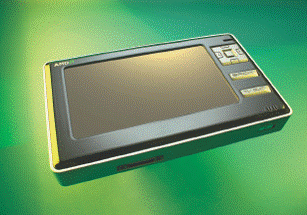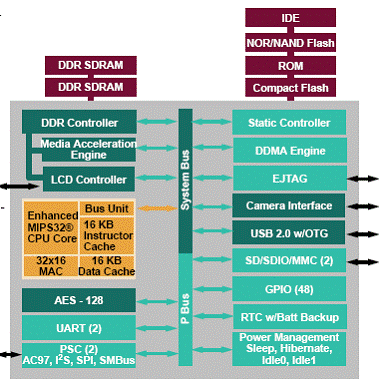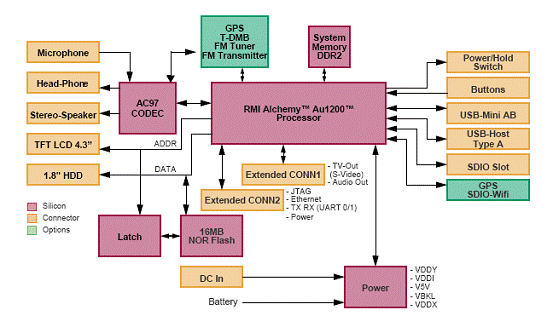RMI 公司的Alchemy
Au1200 是系统级(SoC)处理器,能开发出全特性的个人媒体播放器(PMP).
Au1200采用定制的MIPS32内核,工作频率为333, 400和500MHz,32位架构,16KB指令+16KB数据缓存,具有媒体加速引擎(MAE),支持
MPEG1, 2, 4和WMV9,分辨率可高达1024x768,工作温度从-40度到100度C,非常适合用在PMP,汽车电子和数字媒体适配器(DMA).本文介绍了Alchemy
Au1200的主要性能,方框图以及DBAu1200开发板的主要特性,外形图和方框图.
RMI ALCHEMY AU1200 PERSONAL
MEDIA PLAYER REFERENCE DESIGN

The RMI Alchemy Au1200 processor leverages a 5-year commitment to developing high-performance, low-power solutions to provide a purpose-built, versatile processor for Personal
Media Player (PMP), Automotive, and Digital
Media Adapter (DMA) applications. The Au1200 processor enables users to download media quickly and enjoy DVD-quality
video efficiently delivered at full-frame rates, with low power, and with ample product features. The RMI Alchemy Au1200 processor gives
system designers an easy-to-use, simple solution to create full-featured PMPs with greatly reduced design cycle times. System-on-a-Chip (SoC) architecture eliminates the need for additional components.
The processor is available in an extended temperature range option of -40℃ to 100℃ for all speeds.
Au1200基本特性:
Customized MIPS32 Core
333, 400, and 500MHz
32-bit architecture
16KB instruct + 16KB data caches
High-speed multiply-accumulate (MAC) and divide unit
1.2V core, 3.3V I/O
Media Acceleration Engine (MAE)
Support for
MPEG1, 2, 4, and WMV9 scaled up to 1024x768
MPEG2 main profile/main level (720x480, 10Mbps, 30fps)
MPEG4 advanced simple profile/level 5 (720x480, 4Mbps, 30fps)
WMV9 main profile/medium level (720x480, 2.5Mbps, 30fps)
DivX certified portable
DDR SDRAM Controller
Supports 2.5 or 1.8V DDR1/DDR2 and mobile DDR memory with speeds up to DDR500
16/32-bit data, 14-bit address
Up to 512MB (four 1-Gbit devices)
1:1, 2:1, 3:1
system bus clock to memory clock options
Unified memory architecture with dedicated
video sub
systemStatic Bus Controller
16-bit data bus interface
IDE interface with support for PIO mode and multiword simple DMA data transfers
Support for both NOR and NAND Flash devices
— Boot from NAND or NOR Flash
— Supports 30 bits of addressable memory using 15 pins and address latch protocol
Compact Flash/PCMCIA
Support for external 10/100 Ethernet controller
AES Hardware Encrypt/Decrypt Engine
AES 128
ECB, CBC, CFB, OFB modes supported
100/50/25/12MHz clock option for power/performance considerations
LCD Controller
Up to 1024x768 resolution screens
32-bits per pixel aRGB color resolution support
Four prioritizable overlay windows
Alpha override and per-pixel alpha blending
Four-color hardware cursor
Configurable on-chip memory area for palette RAM, gamma correction, or 1KB frame buffer
Integrated Peripherals
Two Programmable Serial Controllers (PSCs) – each independently capable of being programmed for AC97, I2S, SPI, and SMBus (system management bus) serial protocols
Two Secure Digital/SDIO/MMC Controllers
USB 2.0 Host and Device Controller with HS, FS, and LS support (for both)
— Configurable Host, Device, OTG (On-the-Go) support
Two UARTs
GPIO (48)
Camera Interface Module
8-10 bit parallel data bus
Planar modes support CMOS/CCD sensors
CCIR 656 data input
CIM image data is autonomously planarized in RGB or YCbCr format, relieving the core from the actual work
A Raw Data Mode supports moving CIM input data unchanged to memory
Power Management Modes
Sleep
Hibernate
Idle0/Idle1
Other
Low power
Package: Pin count 372 Plastic BGA

图1.Au1200方框图
High-Performance, Low-Power Solution Optimized for PMP, Automotive, and DMA Applications
The RMI Alchemy Au1200 processor delivers maximum performance with minimum effort – full-function personal media on milliwatts of power.
No transcoding required
No need for DSP
No SDRAM bottlenecks
Unified memory architecture
Media Acceleration Engine (MAE)
Built-in decryption hardware for digital rights management
LCD controller design optimizes displays
The Au1200 processor features an LCD controller that gives developers full 32-bit RGB capabilities in each of four prioritized overlay windows that require no frame buffer modifications to reposition. The Au1200 also features gamma correction for matching
video displays with graphics, a global background color that simplifies processing and produces an aesthetically pleasing display, and a 1KB palette RAM frame buffer that is ideal for displaying information in portable device idle modes.
Camera interface module supports today’s popular features
The Au1200 processor also features a Camera Interface Module (CIM) that provides an 8- or 10-bit data bus for input from CCD/CMOS sensors or other CCIR656 data. The CIM supports pixel clock rates up to 33MHz, and adds popular capabilities including image capture and analog TV display.
CIM image data is autonomously planarized in RGB or YCbCr format, relieving the core from additional work, and is routed to three separate FIFOs. Output is then moved to memory using DDMA.
Planarized data can take advantage of the scaling, filtering, and color space conversion capabilities of the MAE.
RMI Alchemy DBAu1200开发板
The RMI Alchemy DBAu1200 development board is an allinclusive hardware and software tool suite that enables product developers to quickly and easily design and test next-generation digital media devices. The DBAu1200 development board includes a complete set of features for the development and testing of operating system and application software for products based on the low-power, high-performance digital media capabilities of the RMI Alchemy Au1200 processor.
The DBAu1200 development board is a logical extension of the capabilities of the Au1200 processor. This System-on-a-Chip (SoC) provides on-chip decoding of virtually all digital media formats, including
MPEG1, 2, and 4; DivX 3, 4, and 5; H.263; and WMV9 video at D1 resolution (720 x 480) on handheld media-rich devices, without the need for transcoding.
The development board is designed to optimize the strengths of the RMI Alchemy Au1200 processor, such as its unified memory architecture, descriptor-based DDMA engine, and broad device support.

图2.DBAu1200开发板外形图
Hardware
The RMI Alchemy DBAu1200 development board is delivered complete and is configured and ready to run all leading development software programs. The development board is designed around the Au1200 processor and also includes DDR2 and Flash memory devices, all other associated semiconductors, and connectivity support for all peripheral devices.
The development board also features programmable serial controllers and power supplies and is delivered with a 1.3-megapixel digital camera, and an EJTAG header supports monitoring and debugging and provides full-board reset.

图3.DBAu1200开发板方框图
Software and Documentation
The DBAu1200 development board helps designers become productive quickly with an included Quick Start CD that contains a Windows CE demo and media codecs, plus the Linux operating system kernel and Linux development tools.
The development board also includes Personal Media Player (PMP) and Digital Media
Adapter (DMA) applications that can help to produce enhanced development cost savings. In addition to a Quick Start Guide, the CD also contains processor design files, application notes, the YAMON monitoring and debug assist software, and data sheets for each major board component.
DBAu1200开发板主要特性:
Processor
RMI Alchemy Au1200 processor – directly soldered on board, not socketed
VDDI = 1.2V (switchable from 0.925V-1.275V)
MIPS32-based core that provides a simple programming model and well-established toolchain
Hardware Media Acceleration Engine (MAE) that autonomously performs the most demanding parts of video decoding, and also provides scaling, filtering, and color space conversion for any display data
32-bit aRGB LCD controller
Camera Interface Module for glueless interfacing with CCD/CMOS sensors and analog TV devices
AES encryption/decryption allows hardware acceleration for content Digital Rights Management (DRM)
Memory
DRAM: Two ranks of 512Mbit DDR2-533 devices (256MB total)
NOR Flash: 2 x 256Mbit MirrorBit NOR Flash (64MB total), swap-boot between pairs
NAND Flash: 1 x 8 (128MB or 256MB total) device is restricted to CS[1]#, and is not bootable
Expansion
PCMCIA: Dual Hot-Swappable slots
DaughterCard Connector
Memory-mapped Registers
Onboard Peripherals
USB: Two USB ports for USB 2.0 Host and Device Controller that supports OTG
(On-The-Go) protocols:
— 1 Host + 1 Device, or
— 1 OTG + 1 Host, or
— 2 Hosts
— HS, FS, and LS support for both host and device
IDE: PIO Mode with Multiword DMA; standard IDE connector
Memory-mapped Ethernet MAC/PHY: SMSC LAN91C111
UARTS: Two UARTS:
— U0 is Rx_D/Tx_D only,
— U1 with full RS-232 handshake (from GPIO[14:9])
SD-Card: 1 connector on SD0 Port
Camera Interface Module: 1 2x16 stake-pin connector for included OmniVision OV9640FBG camera (1.3Mpixel)
LCD Interface: three output options:
— Generic Connector
— CRT DAC: Converts LCD signals to CRT signals output to VGA connector
— LVDS Transmitter output to backlight inverter connector
TV Interface: Focus Enhancement FS453 PC > TV video scan converter provides NTSC/PAL S-Video out; with adapter cables can support composite, component (720p), SCART
Programmable Serial Controllers
Two Multiplexed pairs:
— PSC1 Pair (Only one of these two may be operational at any given time):
AC97: SigmaTel STAC9752T with stereo mini-plug jacks for 1 line-in, 1 headphone out, and 1 microphone – I2S: Wolfson WM8731 with stereo mini-plug jacks for 1 line-in, 1 headphone out, and 1 microphone
— PSC0 Pair (Only one of these two may be operational at any given time):
– SMBus: Temp/Voltage Monitor and Serial EPROM
– SPI: Temp Monitor and RMI SPI-Flash
EJTAG
2 x 7 pin connector to Au1200 processor; able to reset the entire board from EJTAG
Power
Software power-off capable
System power-on from Au1200 WAKE# signal
Coin cell battery on VDDZ (Real-Time Clock); populated, and spare battery is included
PC Power Connector (for attached PC devices such as IDE drive)
VDDI switch selectable (0.925V – 1.275V); default is 1.2V
Power-up/power-down sequencing circuit (VDDX, VDDY)
Four-voltage supervisor monitor/reset circuit
Board Software Reset
Single +12V DC external power supply
Onboard high-efficiency switch-made regulators to create these voltages: VDDI, +1.8V, +2.5V, +3.3V, and +5V
Kit Content
RMI Alchemy DBAu1200 development board
Power supply and cord
OmniVision Model OV9640FBG 1.3 MP camera
Serial cable for YAMON
Replacement battery for RTC
Documentation/Demo CD
— Quick Start Guide, Design files for DBAu1200 development board, data sheets for major silicon components, application notes, etc.
— YAMON monitor/debugger software
— Windows CE demo – boot loader and nk.bin image
— Linux – kernel and tools, device drivers, RMI media player software
— Personal Media Player and Digital Media
Adapter applications



